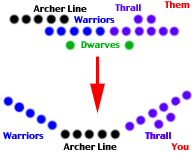The Basic Pincer
By Joshstar
Long ago before Myth was released, back in the demo.net days, there
were two classes of players. The "campers" who fled battles like the plague, and the reckless
"newbie rushers" who just wanted a good battle and didn't care
about winning necessarily . The former were performing a successful
strategy and it was their choice, but the later were gaining a
far more valuable experience. They soon learned ways to eliminate
equal sized armies while maintaining enough of their own forces
to still have a chance at winning the game. The primary tactic
used was a pincering maneuver that involved a wall of thrall closing
in on one side of an enemy mass, and a wall of warriors clashing
from the other side. There are some basic principles that were
instrumental to the success of the pincering maneuver.
Key Concepts
1) If 8 warriors attack 8 warriors while 14 thrall attack 14 thrall,
both sides are going to take heavy losses and the only deciding
factor is luck. However, if 8 warriors AND 14 thrall combine their
attack on the 8 warriors they are guaranteed to kill the warriors
much faster and thus take less damage to themselves. Now there
are more surviving warriors to team up with the thrall in attacking
the opposing ones. With 14 thrall AND some warriors attacking
14 thrall they are guaranteed to win that skirmish as well.
2) If an unorganized clump of melee units allows themselves to
be enclosed by an equal sized group as shown in the graphic to
the right, they will have a huge disadvantage. As you can see,
their are an equal number of units fighting for both sides, but
the enclosed group has several units trapped in the middle (marked
with X's) and unable to get hits off while the enclosing side
is able to use their entire force on the exposed units effectively
giving them a 13:7 advantage while the 6 enemies are obstructed
in the center.
3) If you win the archer battle but lose the melee skirmish, the
remaining enemy warriors will run down your archers and you will
be screwed. The primary purpose of the archer is to support your
infantry and increase the odds of their victory in the melee.
Engaging enemy archers with your own is the same as sending 8
warriors against 8 warriors and watching them kill each other.
Archers can be used much more effectively by carefully shooting
at the backs of enemy melee troops while fighting your own. Furthermore,
do not go out of your way to protect your archers if it will compromise
your success in the melee. In other words, don't try to pull more
then 1 or 2 warriors out of the skirmish in order to chase a horde
of ghols after your archers.
[See Keys to Winning for more on these concepts]
Applying the Concept
The basic defensive pincer involves fanning out in a snare with
your archers in the middle as shown in the picture below. Inch
the formation forward altogether until your archers are in range
to start scatter firing on the enemy mass. 
In the good old days you could move your archers even further
forward to first pick off enemy dwarves, then count on them to
charge your exposed archers with warriors. Then all you had to
do was use your archers as bait and retreat them backwards while
your warrior and thrall lines on either side hinged in on the
poor enemy mass from the sides.
It is often useful to engage your archers with the opposing ones
for a moment while you break off 1 or 2 warriors from the pincer
action to run down the enemy archers. Then if your melee skirmishers look
like they need help, forget about the enemy archers and start
firing arrows into the backs of the opposing melee units. run down the enemy archers. Then if your melee skirmishers look
like they need help, forget about the enemy archers and start
firing arrows into the backs of the opposing melee units.
With the pincering maneuver and the arrow support your melee should
win the skirmish with many survivors and if you have any archers
they should have no trouble cleaning up the remaining enemy archers
along with some charging warriors or thrall for distraction.
Now that is a perfect pincer. |





